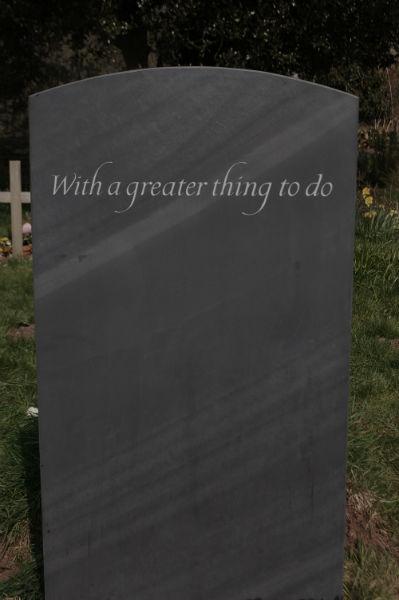Tips for Choosing an Inscription for a Headstone
Choosing the wording for a headstone or memorial can be a really difficult and even stressful process. I have been carving headstones for over ten years, and I want to share some ideas to help you choose the right wording.
1.Try to keep it simple
A shorter inscription will always have more impact than a long one. Although you may have many things you want to include on the headstone, it is always best to ask yourself if you really need so much on the stone.
For example, there is no legal requirement to include the whole name and dates, and in some cases just the first name may even have more impact!
Try to keep it simple, and the overall look and feel of the stone will be stronger.
2.Avoid copying others
If you look at monumental masons' websites there are always templates to choose from. If you can, avoid these and follow your own heart. Choose your own words and try to avoid trends. For example there is a trend at the moment to begin a stone with "in loving memory" just as in the past it might have been "here lies". Ask yourself if you really need or want to start the inscription with these words.
3.It is not just about the words
Don't forget that there is more to a headstone than the wording. Look at the design, the letterforms, the shape of the stone, and perhaps a carving at the top or reverse. For example you might want to think about other senses like touch, and commission a headstone which is rounded to the touch, or perhaps a gilded, sunken bowl to represent eternity.
4.The material you choose will influence the inscription
Different headstone materials require different sized letterforms. This will have an impact on the length of the inscription. For example, a limestone headstone requires large, bold lettering, and therefore a shorter inscription. If on the other hand you choose a slate headstone, this will take lots of small italic letters and a longer inscription.
You need to decide what is most important, the material or the inscription, and then work from there.
5.The epitaph
You may not want an epitaph, but should you choose one, don't forget that there are many options for placement. It can run along the side of the headstone, or be on the back of the stone. It may be in a circle or it may run around the rim. Don't be restricted to putting it on the front. Using the reverse of the stone allows for a longer epitaph without cluttering up the front.
6.Take your time
Do not be hurried into choosing a headstone. I always advise waiting at least a year before even thinking about the inscription.
When grief is raw the words you want may be too emotional and then when you look at the stone years later you may regret what you chose. Leaving it a year allows emotions to settle and gives you time to think about what really matters to you.
Do not feel pressured to place a headstone on the grave. You will not be judged for waiting, and in the long term, when others see what a beautiful and thoughtful headstone you have chosen, they will understand why you waited so long. Sadly people often feel hurried and ashamed of leaving a grave marked only with a temporary marker. Don't forget this is your loved one, and you alone should decide when the time is right.
7.Look for inspiration
There are countless images on the internet of beautiful headstones to inspire you, and in addition looking around churchyards can help.
Do not settle for the first monumental mason who is recommended to you. Have a look at different stone carvers and find one whose style really speaks to your heart. Finding an individual who can guide you and work together with you is very important, and you should not feel rushed or hurried into making a choice.
I always encourage you to choose your own epitaph but if you need inspiration I have compiled a list of epitaphs .
.
For more advice and inspiration on choosing a headstone visit my blog, The Headstone Guide.
Article Images





Comments